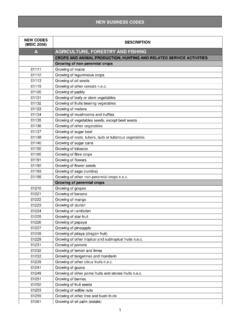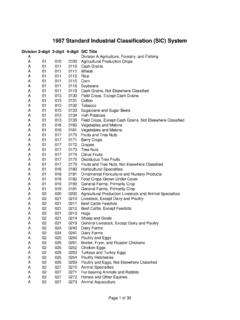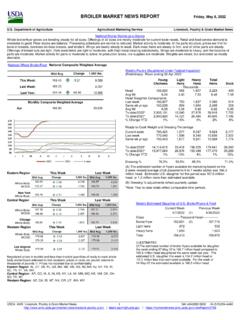Transcription of The Broiler Project - LSU AgCenter
1 TheBroiler Project TheBroiler Projectplastic orvisquineto protectbroilersfrom cold weather and wind. Also, broilerscan be raised successfully on the floor of ashed or need some form of bedding or litterto help keep them warm and to absorbmoisture. Wood shavings, sawdust or ricehulls are good litter choices. The floor of thebroiler pen should be covered with a layer oflitter at least 3 to 4 inches deep. The cakedlitter should be removed every day. Also, therest of the litter should be turned or stirredup once a day to make it absorb more mois-ture and last longer between the litter weekly, depending on thedampness of the need to be housed in a cleanand dry environment. The Broiler penneeds to have some form of protectivesiding (such as 1-inch chicken wire), aroof, ventilation, a form of heating(brooders or heat lamps), and feedingand watering site selected for Broiler housing iscritical.
2 The site should be high and, ifpossible, the floor of the pen should beat least 6 inches above ground level toprevent Broiler pen needs to be big enoughto provide 2 square feet of floor spaceper bird, and the pen should be at least36 to 48 inches in height. A roof is neces-sary to protect the broilers from rain anddirect sunlight. The sides of the pen canbe made of wire that can be covered withThe Broiler ProjectRaising broilers can be fun. Broiler projects are suitable for youth of all ages, from begin-ners to those with many years of experience. Also, Broiler projects are well suited for thosewith limited space for housing animals. By following recommendations and setting up adaily routine of care, young people can have a successful and rewarding show Broiler Project involves raising chicks from one day of age to market weight at 42 to 49days of age.
3 The broilers require some type of housing to provide protection from predatorsand to create an environment to promote growth; however, the facilities and space forbroilers do not need to be expensive or elaborate. The primary objective of producingbroilers is to optimize growth, so 4-H ers involved in the Broiler Project will need to beconcerned with the following: housing, brooding, heating, lighting, feeders and waterers,feeds and feeding, and ChickArrival1. Clean and disinfect thepoultry house andequipment (about twoweeks ahead).2. Cover the dry floor withlitter (3-4 inches ofshavings, sawdust,rice hulls).3. Prepare and set up thebrooder guard (18inches high).4. Place feeders andwaterers in a circlearound the Operate the brooderfor at least 24 hoursbefore chick temperatureshould be set at 92-95F, and the temperatureshould be reduced 5degrees each weekuntil the chicks arethree to four weeksold, or use one 125-watt bulb per Fill the feeders andwaterers a few hoursbefore thechicks need a source of heat to keep them comfort-able.
4 For the first week, the chick s environment needsto be in the range of 90 to 95 F. Reduce the tempera-ture gradually, five degrees each week, until the broil-ers are three to four weeks old or until the pen tem-perature is 70 the first week of brooding, a cardboard or tinbrooder guard (brooder circle) can be used to keep thechicks near the heat source. The brooder guard shouldbe 18 inches tall. The diameter of the brooder guardwill depend on the number of chicks. For example, abrooder guard for 50 chicks should have a minimumdiameter of 5 feet. When chicks are seven days old,remove the brooder guard and allow chicks to movearound the entire first seven daysof brooding are themost critical forproperly heating andcaring for broilerchicks. If chicks arechilled, they won tgrow properly. If chicks are too warm, they can be-come dehydrated.
5 This may lead to death or delayedgrowth. Thus, it is important to begin operating theheat source at least 24 hours before the chicks that 24-hour period, the heat source should be set towarm the brooding area to 90 to 95 F as well as toheat the litter adequately. Use a thermometer to checkthe pen temperature. (Note: Monitor the temperature atthe floor level.) After the first seven days, reduce thebrooding temperature gradually by five degrees eachweek until the broilers are about four weeks heat lamps (infrared bulbs) or gas orelectric hover-type brooders can be usedfor the heat source. The electric heat lampsare a good and popular source of 125-watt bulb is needed for each 252chicks. A light with a red finish can be used to dull the light. Also, the heat lamp should besecured so that it cannot fall into the litter, and all electrical wiring needs to be adequate forthe size of bulb using a heat lamp, you can change the brooding temperature by adjusting theheight of the heat lamp above the floor.
6 The temperature should be monitored with a ther-mometer at chick level and by observing the chicks response to the heat source. Coldchicks will huddle together under the heat source; hot chicks will move to the outer limits ofthe brooder guard, and comfortable chicks will stay in a semicircle around the heat guide can be used to adjust the brooding temperature when using a heat (days) Height of Heat Approximate Lamp (inches) Temperature (oF)0-7 18958-14 219015-21 248522-28 278029-35* 3070-75*Use the heat lamp only if air temperature gets cold. Brooderheat is generally not needed after 28 days; however, do not letthe temperature go below 70 should be provided 24 hours a day for hour light (natural and artificial) will increasefeeding time, increase weight gain and improve featheringin broilers .
7 One 40-watt bulb is needed for each 200 squarefeet of pen space. Hang the bulb at least 6 feet above , you should expose your chicks to lights-out for a shortperiod, 10 to 15 minutes, once or twice early in the will prevent panic or piling if the electricity goes offduring the must have adequate feed and water space to growto their maximum potential, and the amount of requiredfeeder and waterer space increases as the broilers getbigger. Keep the feeders and waterers clean at all and WaterersAfter ChickArrival1. Introduce chicks tofeed and water. Keepfeed and water avail-able to the chicks at alltimes. Provide fresh,clean feed and Adjust the brooder lightif needed. For brood-ers, maintain thetemperature for thefirst week and thenreduce the tempera-ture 5 degrees eachweek. For heat lamps,raise the lamps whenchicks appear to betoo warm: 18 incheshigh for the first weekand then raised 3inches per Observe the chicksclosely and Provide plenty of freshair without Keep the litter Walk among the Once the brooder/heatlamp is removed,provide another sourceof needs to be enough feeder space for all broilers to eat at one time.
8 From one to 14days of age, at least 2 linear inches of feeder space per chick is needed. Chicks will needat least 4 linear inches of feeder space from 15 days of age until the end of the should have feed in them at all times. To prevent feed wastage, fill the feedersonly one-half full. Also, to prevent litter and defecation from getting into the feeders, raisethe feeders off of the floor as broilers grow. The feeders should be kept at a height that islevel with the birds back also must have access to fresh, clean water at all times. Feed consumption isdirectly related to water consumption, so adequate waterers are necessary to optimizegrowth. You will need at least two 1-gallon waterers per 50 chicks from one through fourweeks of age. More waterers or larger waterers are needed for chicks over four weeks ofage. You will need to provide at least 1 linear inch of water space per Broiler .
9 The waterersneed to be cleaned and filled with fresh water daily. The height of the waterers needs to beraised as the broilers grow. The lip of the waterer should be level with the height of thebroilers broilers must be provided proper nutritionfor optimum performance to result. Commercialfeeds contain adequate nutrition to provideoptimal growth. You should let your feeddealer know what type of feed you will needabout two weeks before you get your will ensure that you have fresh, quality feedwhen your chicks should be fed a high protein diet to stimulate can be fed a turkey or game bird starter (26% to 30%protein) for the first two weeks. Then, broilers can be switchedto a Broiler feed (20% to 23% protein) for the remainder of the the last two weeks before the show, you may want to use asupplemental feed to stimulate feed intake and increase growth.
10 Thesupplemental feed simply can be the Broiler feed moistened with milk andcooking oil. The supplemental feed should be fed several times a day, andyou should not put out more supplemental feed than the birds can eat in 10to 15 minutes. Also, fresh supplemental feed should be prepared at eachfeeding and any leftovers should be discarded. Do not save the preparedsupplemental feed for a later supplemental feeding option is to prepare a cookedcorn supplement. There are several recipes for cookedcorn supplements. One recipe calls for one partFeeds and Feeding4corn gluten meal, three parts yellowcorn meal and four parts Broiler ingredients are combined in a largeboiler, and one stick of margarine per 20 ouncesof corn meal and 2 ounces of fresh or evaporated milkfor each ounce of corn meal are added. The margarine is melted, themixture boiled and cooked for three to four minutes.















